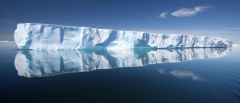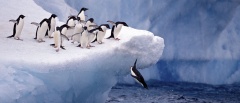Ross Sea
Nicknamed 'The Last Ocean' the Ross Sea is the most pristine area of ocean left on earth...
The southernmost part of the Southern Ocean, the Ross Sea fills the large dent in the continent, just south of New Zealand. Home to the vast ice cliffs of the Ross Ice Shelf, this area is one of the most unforgiving and isolating parts of Antarctica. Due to the colder, more extreme conditions, fewer species are actually found here, but reaching the Ross Sea has one distinct appeal – it offers the chance to sail as close as you can get on a boat to the South Pole.
The sea is named after the British admiral James Ross who discovered the area in 1841. Most Antarctic cruises leaving from Punta Arenas or Ushuaia will only go as the Polar Circle and the sub Antarctic Macquarie Island. From here it takes another 4 days to reach the Ross Sea or a cruise from New Zealand will arrive in 6 days.
Although there is less biodiversity in the Ross Sea, the Adelie penguin rookery at Cape Adare is the largest in the world, with over 100 000 breeding pairs. King penguin colonies can also be found here, although not in such large quantities.
This is also one of the best areas to visit for those interested in the history of expeditionism in Antarctica. Home to the largest modern scientific station in Antarctica, the US –owned McCurdo station, the land around the Ross Sea has always been a base of human activity in Antarctica.
Cape Adare is home to the oldest building in Antarctica, built by members of the Norwegian Southern Cross Expedition in 1899. This expedition accomplished a number of ‘firsts’ in Antarctica, being the first team to spend a winter ashore in Antarctica, the first to use sled dogs and the first man to be buried on Antarctica. The hut has withstood the unforgiving Antarctic weather remarkably well and still bears the marks of the team who stayed there, including poems, mathematical calculations and drawings graffitied on the hut’s walls.
The thin strip of land known as Cape Evans, is famous for having been the starting point for Robert Scott and his fatal trip to the South Pole. The building they erected here is still standing today and is preserved as a museum, offering the chance to get a glimpse of what it was like to live there in the early 1900s.
Finally, the hut from Ernest Shackleton’s first Antarctic expedition in which he and three others aimed to reach the geographic South Pole, remains at Cape Royds, at the westernmost point of Ross Island. The hut later saved the lives of the men who became marooned at Cape Evans during the 1914-17 Trans-Antarctic Expedition and can still be visited today.



